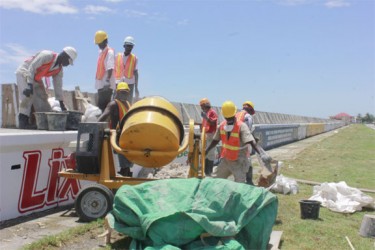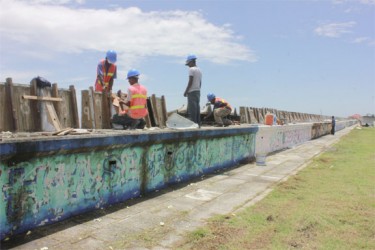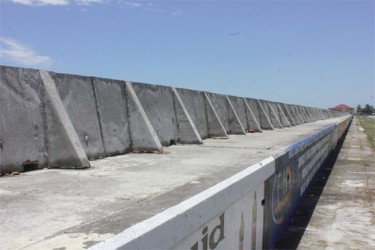The construction of the one-kilometre stretch of mobile wave wall on the seawall, along the Rupert Craig Highway from Liliendaal to Conversation Tree, is expected to be concluded in early September, almost doubling the original time frame for the project.
Project engineer Maitland Stewart said that the inclement weather has been burdensome to the $20 million construction project. He said that the construction had been stalled due to the rains, while noting that the physical construction of the 0.7 meter-high by 2.4 meter-wide units had to be modified to allow for quicker assembly.
Stewart said that the individual pieces that comprise the wave wall are being bolted down to the existing seawall but if necessary the wall can be moved further along the coast where high tides are expected next. He said that the design construction of the wave wall was modified and intended to be a movable structure due to the changing weather patterns.
He also said that a more permanent solution was originally looked into but at a cost of over US$2000 per meter, an extended berm, a type of rip-rap was not cost effective as the erosional front that was currently allowing the water to tumble over the wall was moving.
The project is fully funded by the Public Works Ministry and so far the cost per meter has worked out to be US$100. Stewart said that there has been significant evidence that the foreshore along the area is building up once again but while the mud was there it was still soft and without proper protection it could wash away again, leaving the shore exposed.
“We believe that the extension is adequate…we needed a quick intervention and the rock solution, the extended berm was good and would minimise erosion, but spending billions on an erosional front that was moving did not make sense,” he said.

“We are monitoring the foreshore. This will take two to three years. We will monitor. We don’t want to prematurely spend on rip-rap and it is a white elephant,” he added, while noting that the wave wall was somewhat of a compromise since anything heavier on the existing sea wall would compromise the pre-existing structures.
He said that “we have to proceed with caution in these matters. We need to be sure where the erosional front is going and we’ve seen evidence it is moving… this is not a fixed structure, it is pinned. We just clip it and move it down when we see the front moving.”
When Stabroek News asked about the strength of the new wave wall and what force it could withstand, Stewart noted that the wall extension was being built to withstand the strong winds and the power of the water that pounded the East Coast in late April, causing overtopping and flooding. He said “in respect to force, the waves in April were 1.5 meters high and the wall [is] being built up to handle that.” He added that the exact energy the wall could withstand was analysed prior to construction starting.
He noted that “we did some initial calculations based on the existing information that was collected and we are confident that any situation the extension will be able to handle it.”
Public Works Minister Robeson Benn said that the “we aren’t putting a billion dollars in mud when this is going to do the job”. He noted that the experimental wall would be tested soon enough and currently the wall may be extended up to an addition 500 meters. He said that the foreshore restoration was a positive sign and rip-rap due to cost had to be used in much damaged areas with no sign of erosion rehabilitation.
When Stabroek News visited the site yesterday there was a large crew utilising the sand bags that are along the highway mixing cement to create the individual wave walls and another crew that was assembling the wall. While the project is being completed by the ministry, a single private contractor was hired to assist with the assembling of the wall and ensuring that the non-stationary structures were bolted down.






